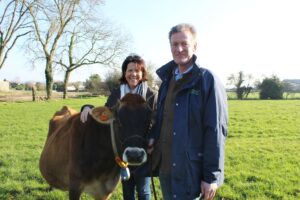An account of this walk from St Saviour to St Peter appeared in the Autumn 2013 issue of RURAL – Jersey Country Life magazine,necessarily abbreviated because of constraints on space. The full text follows below. The author is PHILIP STEVENS
‘So much of Jersey is built up, that it comes as a surprise that you can walk for miles without leaving the rural centre of the Island. This nine-mile walk goes down lanes and across valleys, from St Mannelier in St Saviour to St Anastase in St Peter, linking these two 15th Century free grammar schools.
St Mannelier’s school was founded by Jean Hue in 1477 and endowed by the Jersey merchants Vincent Tehy and Jean Néel, finally closing in 1863. Here Richard Valpy, strict disciplinarian of Reading School; Daniel Dumaresq, Russian scholar; Dr John Lemprière of the Classical Dictionary; Philippe d’Auvergne later Duc de Bouillon; and, almost certainly, Philip Morant, historian of Essex, were educated. John Wesley, visiting and preaching in Jersey in 1787, said the school was ‘exceedingly finely situated in a quiet recess surrounded by tall woods’. The house and the school building have recently been well restored. [198]
We go south and then immediately west on a narrow lane, Les Ruettes. To the north is Les Landes Pallot, where there used to be a rocking stone. The shaded lane leads down to Grands Vaux. In the valley on the left is the Moulin de Louis Pol, [199] where corn was milled for centuries, and where the artist, the late Robert Tilling, lived. We turn up Mont de la Rosière. On the east is the avenue of chestnuts leading to Beau Vallon; [200] a century ago they were Jersey elms. At the top of the hill, we turn down the road called after La Commune de S. Sauveur. You can go into woods on the left towards the filter beds of Grands Vaux reservoir and loop back to the road. [201-2] At the bottom of the road, near La Tapinerie, is a very green water-meadow surrounded by trees, the Pré du Ponterrin, given to the National Trust by Sybil Perrée.[203-4]
Turning north along the Rue au Bailli, [205] we see on the right the ruins of Ponterrin Mill; [207] a mill on the site was probably the one given by William the Conqueror and his Queen, Matilda, to the Abbaye aux Dames in Caen. We go east up the hill between the mill buildings, and past the Eric Young Orchid Foundation to Victoria Village, formerly called La Boucterie. On the Rue Roncole, we go past Les Grès and down into the valley again. Opposite the entrance to La Planque, a signpost on the west says ‘Le Ruelle du Mont Ifer’. This goes in a semi-circle through a delicious part of the valley, and round to the Rue de Blanche Pierre. La Blanche Pierre is a large stone, probably a menhir, which was built into a garden wall.
We go along the Rue de Hurel, whose name tells us that that this area was once stony ground, straight across the Trinity Main road, and along Woodlands Lane, which is, unusually, an un-metalled public road. We are now on high ground separating the headwaters of the Grands Vaux and the upper reaches of the Vallée des Vaux.
On to Rue des Pelles to La Croix, which must mark the place of one of the numerous pre-Reformation roadside crosses. From we go down Rue de Bec, which surely preserves the Norman name ‘beck’ for stream. The road is also called after the house called ‘Yuthet’, an exotic and unexplained name. We turn into Rue du Grand Jardin and see on the north a well – tended orchard and Lyndale Sports. [208] At the end, a dogleg leads into Rue de La Garenne. On the right, Le Douët, with its classic Jersey façade in pink granite, [209] and on the left the grounds of Beau Désert, formerly home of the Néel family. There is now a pond in the suitably named Pré Vasé – muddy field. [211-212]
Where the Rue de la Garenne turns left, we turn right into one of Jersey’s rare green lanes (using the term in the Guernsey sense of a narrow lane without motor-traffic, rather than the Jersey sense of a minor, usually tarmac, road with a 15 m.p.h. speed limit). The lane goes north and where it cuts across the Rue d’Empierre is another fine house, La Maison de Bas, with the initials PGC SCV 1819. [155] Following the lane further north, we turn left into to the Rue des Haies, and then south into La Rue du Douët. On the east is Crossbow House, named after the Larbalestier family. We carry on south to Le Becquet Vincent, which means a piece of land belonging to the Vincent family, and carry on down the Rue du Haut de l’Orme, past Rondel’s Farm Shop on the left. We are again on high ground, this time separating the Vallée des Vaux from Bellozanne Valley.
We cross the main St John’s Road at the Union Inn, and follow the Rue de Maupertius down, turning right and then immediately left past The Limes and down into Maupertuis or Fern Valley as this section of Bellozanne is called. [158, 159, 161] (Maupertuis does not mean ‘fern’ though, curiously the Maupertuis in St Mary’s is also called Fern Valley.). On the left, but hidden by trees, are the Bellozanne Works. Et Ego in Arcadia. On the right, and below Surville Manor, is a large Y-shaped piece of National Trust land given it in lieu of land lost in Queen’s Valley. In the valley bottom are yellow flag iris, buttercups and hemlock. The slopes have oak, aspen, hawthorn, holly, bramble and of course fern. Fortunately, there is very little sycamore which has taken over so many valleys in Jersey, and the Men of the Trees have been planting oak and ash in ‘Liberation Wood’.
Back on the road, and going up again, we are on the next spur of high ground, separating Bellozanne from Waterworks Valley. Crossing the Mont Cochon road, we go down La Ruelle de St Clair, recording the name of the Chapelle de St Clair which was nearby. On the corner is the house St Clair, another perfect Jersey façade, with the initials PHM EN 1824 for Pierre Hamon and Elizabeth Noël. Almost immediately, on the right, is a water-lane, dried out at the top, which goes down to the Chemin des Moulins in Waterworks Valley just below where Vicart Mill used to be. This is an ancient site, recorded since 1309. You can still see the wheel-pit and its shape suggests that the wheel was not overshot, as most in Jersey were, but undershot with the water going under the wheel. Old photographs show the three-storey mill building from which teas were served as a side-line. RAF Reconnaissance photographs show that by 1944 it had lost its roof, and it is now reduced to piles of rubble in the undergrowth.
Just above Vicart we go through a grassy area with the St Lawrence millennium stone and get to the bottom of Mont Misère or Rue des Varslor. The lane is pedestrian with a rough concrete surface, and on the sides are gnarled oaks and ferns. Up on the St Lawrence Main Road we are yet again on high ground, this time separating Waterworks from St Peter’s Valley. St Lawrence’s Church is just here, and one can see the porch pillar with its as yet un-deciphered Celtic message, and admire the Hamptonne Chapel. On the west of St Lawrence’s church is the Rue des St Mariais, which reminds us that the people St Mary’s had to go though St Lawrence to get into Town. Just west of the churchyard is a very narrow path called the Chemin des Morts, presumably used to bring coffins from the west part of the parish to the church. To the north is the field called Mal y Tourne which, the farmer told my mother, records the turns and twists of the field boundary. We go down into the side-valley (which starts at Avranches, and goes past the National Trust’s cottage Le Rât, and down into St Peter’s Valley at Tesson Mill).
Still on the Chemin des Morts, we enter this side-valley about half-way; downstream is a water-meadow with splendid woods on its eastern flank. The path goes up past Badier, which has a double farm arch with the initials IRM SGC 1684 for Jean Remon and Sara Gruchy, commemorating their marriage eight years before. The house itself has a double-voussoir arch suggesting that it is very old – perhaps 16th Century. On the right again is a field which is supposed to be the site of the Orme du Conseil – Council Elm. It marked the southern border of the Fief des Arbres; in 1707 Charles Le Brun, who had cut it down, was ordered to replace it with another elm. Straight ahead is a narrow path on the edge of a field; at the end of the path, looking southwards we see the roofs of Sea View (formerly called La Gallichanerie) [165-166] which have recently been thatched, part of an excellent restoration of an ancient house which has several stone fireplaces, a circular stone staircase, and original fenestration.
We now turn north and then east to go past Morel Farm, [167] a star property of the National Trust with double arch, paved farmyard and outbuildings. Various actors have been screened in these very picturesque surroundings, including Susan Hampshire and Annette Bening. Further down the hill, which leads to Le Rât, we see the Ferme Jean Morel on the left and then we turn left and up Mont Isaac to La Ville au Veslet. The old house at the cross-roads at the top carries the initials of Jean Remon and Rachel Poingdestre and the date 1739. It was in terrible condition, but has been superbly restored and thatched, and is now called Petits Hiboux. [168, 169, 170] (I remember that when I was helping my mother with her researches on old Jersey houses in the 1960s, the only thatched properties in Jersey were La Caumine on Mount Bingham, a wing of La Chesnaie in St Lawrence and the gun covering at Beaumont; now there are many others.)
At the cross-roads by the Remon house we turn west along Le Mont Sorsoleil, past the Carrefour des St Mariais and the Rue des Bessières which ends at the Pierre des Bessières, a megalith with cup-marks, where the Catholic Church of St Thomas stands. We are now just in St Peter’s, but we turn south into the Rue de la Ville au Bas, back into St Lawrence’s. La Maison de Bas, on the east side, has another double farm arch, dated 1663, and Amy initials. The mother of Dr Philippe Langlois, pioneer poet of Jèrriais and a founding member of La Société Jersiaise, came from here.
Turning west again along Le Pissot, we see on the left the back of the old house La Citadelle, which carries a date of 1590 and was partly rebuilt some years ago. Going slightly downhill, we see on the left Le Pissot, and old house with a unique flattened arch, looking more English than Jersey. On the right across a field one can see the front of Les Aix, the splendid former Anley property. [172] It stands at the head of the side-valley in which the Germans made the road leading down to St Peter’s Valley at the Britannia Inn.
The road we are on – now called La Rue de Petit Aleval – goes up slightly past the Living Legend on the left; on the right, Greenhill, a perfect untouched façade of 1674 with and arch and nine chamfered windows, and now a hotel, and L’Aleval, another fine house which has many granite features but has lost its chimney-stacks. Straight on from here and above the main valley of St Peter’s, is Le Mont de St Anastase; the old school was on the right. It was built by Tehy and Neel who also endowed St Mannelier, where we started our walk about four hours before.
Not mentioned in text:




